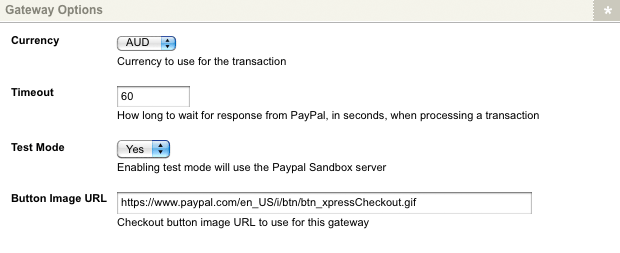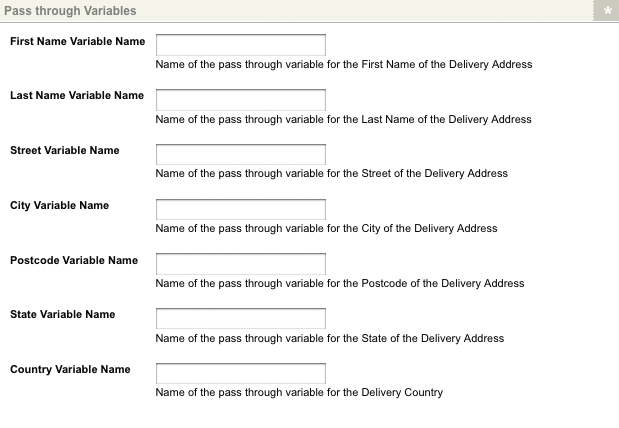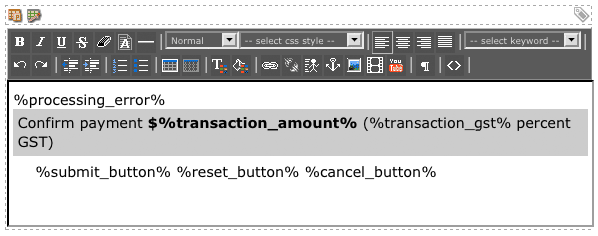PayPal Express Checkout Payment Gateway
Last Updated: 22 Jun 2020
payment_gateway_paypal_express|asset|6.0.0
The current version of the PayPal Express Checkout Payment Gateway asset in Squiz Matrix is using the NVP/SOAP Express Checkout API that has been deprecated by PayPal. Please use a different payment gateway such as Braintree, PayPal Payment, or PayPal Payflow Pro. Development to support the new PayPal Express Checkout API method is in consideration but not yet available in Squiz Matrix.
The PayPal Express Checkout Payment Gateway allows you to create a payment solution for your customers, utilising PayPal's express checkout payment options. Please note that in order to use the PayPal Express Checkout Payment Gateway, you will need a PayPal Business or Premier account, capable of accepting payments via express checkout.
Please note that the PayPal Express Checkout online payment gateway posts payment information directly to a remote server. Squiz Matrix does not personally handle any of the sensitive information managed by this payment gateway and is thus exempt from PCI compliance standards.
Once you have added a PayPal Express Checkout Payment Gateway, you can configure its settings on its associated asset screens. The majority of these screens are the same or similar to those for a Standard Page and are described in the Asset Screens manual. In this chapter, we will describe the Details and Display Formatting screens, which are different for a PayPal Express Checkout Payment Gateway.
Details Screen
The Details screen allows you to configure the settings of the PayPal Express Checkout Payment Gateway. For more information about the Status, Future Status, Thumbnail and Details sections, refer to the Details Screen chapter in the Assets Screens manual.
PayPal Express Checkout API Credentials
This section allows you to input the credentials of the PayPal API used to process express checkout payments. The PayPal Express Checkout API Credentials section of the Details screen is displayed in the figure below.

The PayPal Express Checkout API Credentials section of the Details screen
The fields available in this section are outlined below. The information required for these fields can be obtained when configuring the API on your PayPal account. For more information, refer to the PayPal Developer website.
- API Username: enter the username of the API configured on your PayPal account to process transactions on the PayPal Express Checkout Payment Gateway.
- API Password: enter the password of the API configured on your PayPal account to process transactions on the PayPal Express Checkout Payment Gateway.
- API Signature: enter the signature of the API configured on your PayPal account to process transactions on the PayPal Express Checkout Payment Gateway.
Gateway Options
This section allows you to configure the general settings of the PayPal Express Checkout Payment Gateway and specify the button to display to users for this payment option. The Gateway Options section of the Details screen is displayed in the figure below.

The Gateway Options section of the Details screen
The fields available are as follows:
- Currency: select the currency that will be used in all e-commerce transactions processed by the PayPal Express Checkout Payment Gateway. The following currencies are available:
- Great British Pound (GBP)
- Australian Dollar (AUD)
- United States Dollar (USD)
- Euro (EUR)
- Japanese Yen (JPY)
- Canadian Dollar (CAD)
- Timeout: select the amount of time in seconds that the payment gateway will wait for the user's response before returning an error. By default, this field is set to 60 seconds.
- Test Mode: select whether or not to use the payment gateway for testing purposes only. If this field is set to On, as shown in the figure below, the payment gateway will not process any payments.

The PayPal Express Checkout Payment Gateway running in Test Mode - Button Image URL: enter the URL of the image to display for the PayPal Express Checkout Payment Gateway. This button is displayed to users, allowing them to select this payment option while completing their e-commerce order. By default, this field will use the button at the following URL: https://www.paypal.com/en_US/i/btn/btn_xpressCheckout.gif.
Pass through Variables
This section allows you to source address information for use on the confirmation page of the PayPal Express Checkout Payment Gateway. This information is displayed via keyword replacements available on the Display Format Bodycopy. The Pass through Variables section of the Details screen is shown in the figure below.

The Pass through Variables section of the Details screen
In the available fields, enter the pass through variable keys for the corresponding questions. These keys must be configured on the Ecommerce Rules screen of the Ecommerce Form Page. For more information, refer to the Ecommerce Rules Screen section of the Ecommerce Form Page chapter in this manual. The fields that are available in this section are as follows:
- First Name Variable Name: enter the pass through variable key for the first name of the delivery address.
- Last Name Variable Name: enter the pass through variable key for the last name of the delivery address.
- Street Variable Name: enter the pass through variable key for the street of the delivery address.
- City Variable Name: enter the pass through variable key for the city of the delivery address.
- Postcode Variable Name: enter the pass through variable key for the postcode the delivery address.
- State Variable Name: enter the pass through variable key for the state of the delivery address.
- Country Variable Name: enter the pass through variable key for the country of the delivery address.
Interface Options
This section allows you to change the button and error text for the payment gateway. The Interface Options section of the Details screen is shown in the figure below.

The Interface Options section of the Details screen
The fields that are available in this section are as follows:
- Submit Button Text: enter the text to display as the submit button. By default, this button will read Pay. This button is displayed when the keyword replacement Submit Button is used on the Display Format Bodycopy.
- Reset Button Text: enter the text to display as the reset button. By default, this button will read Reset. This button is displayed when the keyword replacement Reset Button is used on the Display Format Bodycopy.
- Cancel Button Text: enter the text to display as the cancel button. By default, this button will read Cancel. This button is displayed when the keyword replacement Cancel Button is used on the Display Format Bodycopy.
Display Formatting Screen
The Display Formatting screen allows you to edit the Display Format Bodycopy. Please note that this Bodycopy can also be edited by right clicking on the Display Format Bodycopy in the Asset Map and selecting Edit Contents.
Display Format Bodycopy
The Display Format Bodycopy is used to define the layout of the confirmation page of the PayPal Express Checkout Payment Gateway page, displayed to users when they return to your site after configuring their payment within PayPal. The default layout of the payment gateway is shown in the figure below.

The default layout of the PayPal Express Checkout Payment Gateway
To change the information that is being shown, click on the ![]() icon – the WYSIWYG Editor will appear where you can use the keyword replacements and formatting to set the layout of the information to show on the payment gateway page. By default, the information shown in the figure below will appear in the WYSIWYG Editor.
icon – the WYSIWYG Editor will appear where you can use the keyword replacements and formatting to set the layout of the information to show on the payment gateway page. By default, the information shown in the figure below will appear in the WYSIWYG Editor.

The WYSIWYG Editor on the Display Format Bodycopy
By default, the transaction amount on the PayPal Express Checkout Payment Gateway will be listed in dollars. This may need to be changed depending on the currency you have selected on the Details screen.
Keyword Replacements on the Display Format Bodycopy
A list of keyword replacements is provided in the WYSIWYG Editor tool bar on the Edit Contents screen of the Display Format Bodycopy. You can use these keyword replacements in conjunction with text, images and links etc to configure the layout of the payment gateway page. The standard keyword replacements that are available include the following:
- Delivery Address First Name: this will show the customer's first name as specified on the delivery address.
- Delivery Address Last Name: this will show the customer's last name as specified on the delivery address.
- Delivery Address Street (Street Number, Name and Type): this will show the customer's street address as specified on the delivery address.
- Delivery Address City: this will show the customer's city as specified on the delivery address.
- Delivery Address Postcode: this will show the customer's postcode as specified on the delivery address.
- Delivery Address Country: this will show the customer's country of residence as specified on the delivery address.
- Submit Button: this will show the submit button.
- Cancel Button: this will show the cancel button.
- Reset Button: this will show the reset button.
- Transaction Amount: this will show the amount of money that is to be paid in the transaction.
- Transaction Currency: this will show the transaction currency. For example, AUD.
- Processing Error (Empty If No Error): this will show any processing errors. For example, if the user forgets to fill out a field.
A number of these fields are compulsory when creating a working payment gateway. If the required fields are not available to the user, the transaction will not be able to be completed.
